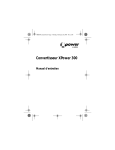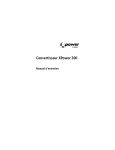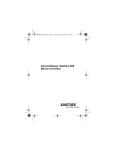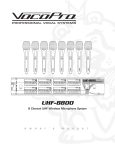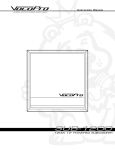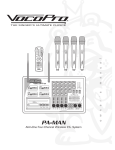Download VocoPro SUB-1500 Operating instructions
Transcript
l a u n a m w n e r ' 200 Watts of Powerful Low-end Bass for Rich and Full-spectrum Audio Experience 15" Long-throw Coated Woofer for Great Sound and Durability Adjustable Crossover for Variable Low-pass Filtering Low-level RCA & High-level MDP Inputs/Outputs Dual-port Enclosure for Efficient Release of Acoustic Energy and Thermal Build-up Small Footprint Design and Recessed Handles for Easy Mobility and Placement Feel the Music with Very Low-frequency Performance to 40hz Full-toned, Low-distortion and Accurate Low-end Bass Response o • • • • • • • • s FEATURES: SUB-1500 200W Powered Subwoofer Safety Instructions CAUTION RISK OF SHOCK CAUTION: To reduce the risk of electric shock, do not remove cover (or back). No userserviceable parts inside. Only refer servicing to qualified service personnel. Explanation of Graphical Symbols The lightning flash & arrowhead symbol, within an equilateral triangle, is intended to alert you to the presence of danger. The exclamation point within an equilateral triangle is intended to alert you to the presence of important operating and servicing instructions. WARNING To reduce the risk of fire or electric shock, do not expose this unit to rain or moisture. 8. Ventilation - The appliance should be situated so its location does not interfere with its proper ventilation. For example, the appliance should not be situated on a bed, sofa, rug, or similar surface that may block the ventilation slots. 9. Heat - The appliance should be situated away from heat sources such as radiators, heat registers, stoves, or other appliances (including amplifiers) that produce heat. 10. Power Sources - The appliance should be connected to a power supply only of the type described in the operating instructions or as marked on the appliance. 11. Grounding or Polarization - Precautions should be taken so that the grounding or polarization means of an appliance is not defeated. 12. Power-Cord Protection - Power-supply cords should be routed so that they are not likely to be walked on or pinched by items placed upon or against them, paying particular attention to cords at plugs, convenience receptacles, and the point where they exit from the appliance. 13. Cleaning - Unplug this unit from the wall outlet before cleaning. Do not use liquid cleaners or aerosol cleaners. Use a damp cloth for cleaning. 14. Power lines - An outdoor antenna should be located away from power lines. 1. Read Instructions - All the safety and operating instructions should be read before the appliance is operated. 15. Nonuse Periods - The power cord of the appliance should be unplugged from the outlet when left unused for a long period of time. 2. Retain Instructions - The safety and operating instructions should be retained for future reference. 16. Object and Liquid Entry - Care should be taken so that objects do not fall and liquids are not spilled into the enclosure through openings. 3. Heed Warnings - All warnings on the appliance and in the operating instructions should be adhered to. 4. Follow Instructions - All operating and use instructions should be followed. 5. Attachments - Do not use attachments not recommended by the product manufacturer as they may cause hazards. 6. Water and Moisture - Do not use this unit near water. For example, near a bathtub or in a wet basement and the like. 7. Carts and Stands - The appliance should be used only with a cart or stand that is recommended by the manufacturer. 7 A. An appliance and cart combination should be moved with care. Quick stops, excessive force, and uneven surfaces may cause an overturn. 17. Damage Requiring Service - The appliance should be serviced by qualified service personnel when: A. B. C. D. The power supply cord or plug has been damaged; or Objects have fallen into the appliance; or The appliance has been exposed to rain; or The appliance does not appear to operate normally or exhibits a marked change in performance; or E. The appliance has been dropped, or the enclosure damaged. 18. Servicing - The user should not attempt to service the appliance beyond that described in the operating instructions. All other servicing should be referred to qualified service personnel. Note: To CATV system installer's (U.S.A.): This reminder is provided to call the CATV system installer's attention to Article 820-40 of the NEC that provides guidelines for proper grounding and, in particular, specifies that the cable ground shall be connected as close to the point of cable entry as practical. 1 Welcome... And Thank you for purchasing the SUB-1500 from VocoPro, your ultimate choice in Karaoke entertainment! With years of experience in the music entertainment business, VocoPro is a leading manufacturer of Karaoke equipment, and has been providing patrons of bars, churches, schools, clubs and individual consumers the opportunity to sound like a star with full-scale club models, in-home systems and mobile units. All our products offer solid performance and sound reliability, and to further strengthen our commitment to customer satisfaction, we have customer service and technical support professionals ready to assist you with your needs. We have provided some contact information for you below. VocoPro 1728 Curtiss Court La Verne, CA 91750 Toll Free: 800-678-5348 TEL: 909-593-8893 FAX: 909-593-8890 VocoPro Company Email Directory Customer Service & General Information [email protected] Tech Support [email protected] Remember Our Website Be sure to visit the VocoPro website www.vocopro.com for the latest information on new products, packages and promos. And while you're there don't forget to check out our Club VocoPro for Karaoke news and events, chat rooms, club directories and even a Service directory! We look forward to hearing you sound like a PRO, with VocoPro, your ultimate choice in Karaoke entertainment. FOR YOUR RECORDS Please record the model number and serial number below, for easy reference, in case of loss or theft. These numbers are located on the rear panel of the unit. Space is also provided for other relevant information Model Number Serial Number Date of Purchase Place of Purchase 2 Listening For A Lifetime Selecting fine audio equipment such as the unit you've just purchased is only the start of your musical enjoyment. Now it's time to consider how you can maximize the fun and excitement your equipment offers. VocoPro and the Electronic Industries Association's Consumer Electronics Group want you to get the most out of your equipment by playing it at a safe level. One that lets the sound come through loud and clear without annoying blaring or distortion and, most importantly, without affecting your sensitive hearing. Sound can be deceiving. Over time your hearing 'comfort level' adapts to a higher volume of sound. So what sounds 'normal' can actually be loud and harmful to your hearing. Guard against this by setting your equipment at a safe level BEFORE your hearing adapts. To establish a safe level: • Start your volume control at a low setting. • Slowly increase the sound until you can hear it comfortably and clearly, and without distortion. Once you have established a comfortable sound level: • Set the dial and leave it there. • Pay attention to the different levels in various recordings. Taking a minute to do this now will help to prevent hearing damage or loss in the future. After all, we want you listening for a lifetime. Used wisely, your new sound equipment will provide a lifetime of fun and enjoyment. Since hearing damage from loud noise is often undetectable until it is too late, this manufacturer and the Electronic Industries Association's Consumer Electronics Group recommend you avoid prolonged exposure to excessive noise. This list of sound levels is included for your protection. Some common decibel ranges: Level 30 40 50 60 70 80 Example Quiet library, Soft whispers Living room, Refrigerator, Bedroom away from traffic Light traffic, Normal Conversation Air Conditioner at 20 ft., Sewing machine Vacuum cleaner, Hair dryer, Noisy Restaurant Average city traffic, Garbage disposals, Alarm clock at 2 ft. The following noises can be dangerous under constant exposure: Level 90 100 120 140 180 Example Subway, Motorcycle, Truck traffic, Lawn Mower Garbage truck, Chainsaw, Pneumatics drill Rock band concert in front of speakers Gunshot blast, Jet plane Rocket launching pad -Information courtesy of the Deafness Research Foundation 3 SUB-1500 200W Powered Subwoofer Contents Safety Instructions........……………………….…………………………………........... 1 Welcome……………….....…………………………….….…………………………........... 2 Listening for a Lifetime.……………………………….…………………….................. 3 Before Getting Started….……………………………………………………….............. 5-6 Understanding Subwoofers...................................................................... 7 Placement Precautions.………………………………….…………........................... 8 Getting Started...........................................…………………………………….... 7 Importance of Location.............…………………………………………............ 7-11 Connecting the SUB-1500…………………….…………….................................. 12-13 Rear Panel Description and Controls......................................................... 14 Powering On Test.................................................................................... 15 Advanced Operations.........................……………………………………............... 16 Troubleshooting…………………………………………………………………….............. 17 Specifications…………………………………………………………………………........... 18 SUB-1500 Features • • • • • • • • 4 200 Watts of Powerful Low-end Bass for Rich and Full-spectrum Audio Experience 15" Long-throw Coated Woofer for Great Sound and Durability Adjustable Crossover for Variable Low-pass Filtering Low-level RCA & High-level MDP Inputs/Outputs Dual-port Enclosure for Efficient Release of Acoustic Energy and Thermal Build-up Small Footprint Design and Recessed Handles for Easy Mobility and Placement Feel the Music with Very Low-frequency Performance to 40hz Full-toned, Low-distortion and Accurate Low-end Bass Response SUB-1500 Features The SUB-1500 features a low distortion internal amplifier, a built-in low-pass crossover, a phase switch, high and low level inputs/outputs and a dual voltage switch. The SUB-1500 is designed to handle a variety of connection options, allowing users increased freedom in system integration. FEATURES: • • • • • • • • 200 Watts of Powerful Low-end Bass for Rich and Full-spectrum Audio Experience 15" Long-throw Coated Woofer for Great Sound and Durability Adjustable Crossover for Variable Low-pass Filtering Line-level RCA & High-level MDP Inputs/Outputs Dual-port Enclosure for Efficient Release of Acoustic Energy and Thermal Build-up Small Footprint Design and Recessed Handles for Easy Mobility and Placement Feel the Music with Very Low-frequency Performance to 40hz Full-toned, Low-distortion and Accurate Low-end Bass Response Before Getting Started Safety 1. Power Source - Operate only from a power source as directed on the unit or in the operating instructions. 2. Polarization - If your unit is equipped with a polarized alternating current line plug (a plug having one blade wider than the other), this plug will fit into the power outlet only one way. This is a safety feature. If you are unable to insert the plug fully into the outlet, try reversing the plug. If the plug should still fail to fit, contact an electrician to replace your obsolete outlet. Note: Do not defeat the safety purpose of the polarized plug by trying to grind the larger metal blade down till it fits in the outlet. 3. Cord Placement - Do not allow anything to rest on, roll over, or pinch the power cord, and do not place the power cord where it is subject to traffic and abuse. This may result in an electrical shock or fire hazard. 4. AC Outlet - Overloaded AC outlets and extension cords are dangerous as well as frayed cords and broken plugs. Avoid compounding these situations by plugging in more appliances to such outlets. Also, try to remove appliances with damaged cords or plugs before adding any more appliances to the area. 5. Nonuse Periods - When the unit is not used, turn the power off. When left unused for a long period of time, the unit should be unplugged from the household AC outlet. 5 Before Gettin Started (cont.) Installation Environment 1. Water and Moisture - Do not use this unit near water - for example near an aquarium or the like. Damp basements should also be avoided. 2. Condensation - Internal moisture may form in the following cases: • Immediately after a heater has been turned on • In a steamy or very humid room. • When the unit is suddenly moved from a cold environment to a warm one • If moisture forms inside this unit, it should not be operated until completely dry. 3. Heat - The unit should be situated away from heat sources such as radiators and the like. It also should not be placed in temperatures less than 5°C (41° F) or greater that 35° C (95° F). Maintenance Clean the panel and controls with a soft cloth lightly moistened with mild detergent solution. Do not use any type of abrasive pad, scouring powder or solvent such as alcohol or benzene. Service 1. Reading Instructions - This is probably one of the most important things to remember. All the safety and operating instructions should be read before the appliance is installed and operated. The life span of your purchase can depend on how well you take care of it. 2. Damage Requiring Service - The unit should be serviced by qualified service personnel when: (a) The A/C mains power cord or plug has been damaged (b) Objects have fallen or liquid has been spilled into the unit (c) The unit has been exposed to rain (d) The unit does not appear to operate normally or exhibits a marked change in performance (e) The unit has been dropped, or the enclosure damaged 3. Servicing - The user should not attempt to service the unit beyond that described in the operating instructions. All other servicing should be referred to qualified service personnel. 6 Understanding Subwoofers Before we get into finding a location for the SUB-1500 and making any connections, we want to be sure we explain some fundamental principles about subwoofer performance. Simply hooking up a subwoofer to an audio system like a loudspeaker can significantly compromise the performance of the subwoofer, and at times even make the system sound worse. Below are some important guidelines regarding subwoofer installations that can help you get a better sound in less time. Room Acoustics The low frequency response and efficiency of a subwoofer are heavily influenced by the acoustics of the playback environment. More specifically, the response is influenced by the room's dimensional ratios, types of construction and location of the subwoofer within that environment. You can significantly improve the subwoofers in-room response and efficiency by experimenting with various room placements until you find an optimum location. General acoustical guidelines to be kept in mind: • Every acoustic space is unique and experimentation is an important key in finding the best possible location in your particular environment. • A subwoofer becomes more acoustically efficient (has greater output) as you move it closer to a room surface (e.g. wall or floor). • A subwoofer will give maximum output and maximum acoustic excitement when it is located in a corner. • Under certain acoustic conditions, corner locations are optimum; in others, they can excite multiple "room modes", producing "muddy" or "boomy" sound. Localization A subwoofer generates tremendous energy, so it may vibrate objects close to it. If you hear buzzing or vibrating objects, make sure to try to dampen those objects. Rattling, buzzing and other sympathetic resonance can make a subwoofer's performance localized. This localization of sound usually prevents a full-toned, full-spectrum sound, and therefore should be avoided. Many times localization can be heard through surface vibration, but using a sine wave generator is probably the most accurate method. 7 Placement Precautions Magnetic Shielding Precautions The SUB-1500 is not magnetically shielded and may damage a TV if placed in very close proximity. If you suspect or see any color distortion anywhere on a nearby TV, the SUB-1500 may be too close and should be moved away from the TV until the color distortion disappears. Basic Precautions DO NOT... • Place your subwoofer directly against a wall, leave at least a minimum of 1" of space. • Place against a radiator, panel heater or forced air-heating outlet • Place outdoors or in a humid environment • Plug into an AC mains outlet until all your system wiring is completed. Interference If you are familiar with wireless microphone systems, we are NOT talking about RF type interference, but rather acoustic interference, or the direct sonic radiation mixed with reflections from adjacent surfaces (especially floors, rear walls and side walls). These sound reflections can be either in or out of phase. What is coming in phase with the direct sonic radiation will reinforce the sound, and what is coming out of phase with the direct sonic radiation will weaken or cancel the sound. If reflections will inevitably occur due to a forced location, try to get as many reflections as possible to arrive in phase with the direct sonic radiation. In addition, it is highly recommended to ensure this is true throughout the entire working frequency range of the SUB-1500 (40- 120 Hz), because different frequencies have different lengths and movement (Refer to Advanced Operation for more information on phase adjustments). 8 Getting Started Unpacking After unpacking the SUB-1500, you will have the SUB-1500 subwoofer, an AC mains power cable and this quick start guide. It is recommended to keep the original packaging material in the case that re-shipping becomes necessary. SUB-1500 Package Contents SUB-1500 AC MAINS POWER CABLE QUICK START GUIDE QUICK START GUIDE AC MAINS POWER CABLE SUB-1500 The Importance of Location As earlier mentioned, room acoustics have an enormous impact on the sound of speakers, especially subwoofers. A phenomenon called "standing waves" makes bass response uneven from place to place in your room. To experience with this yourself, put on a CD with a strong, consistent bass line. Notice how the volume of the bass goes up and down as you move around the room. Stand in one place and then squat down. You will probably notice that the bass changes in the vertical plane as well! Because a subwoofer's location affects how standing waves are created, the first step to getting accurate bass response is finding the right spots for your SUB-1500 and your listening position. Standing Waves Top Down View SUB Sound travels along walls and distributes evenly through room. SUB Most sound is distributed through the middle of the room leading to skewed standing wave presence. 9 Getting Started (cont.) Importance of Location Corner Placement This is the advice most often given because it usually yields a "loud" bass signal, however corner mounting also may cause the SUB-1500 to sound monotone and extra boomy on music. If excessive bass volume is your goal, this may be the answer for you and is worth trying. Corner Placement Highest Bass Output with "Boomy" Sound Medium - High Bass Ouput with Smoother Sound Lower Bass Output with Smoothest Sound ROOM ROOM ROOM Symmetrical Placement Avoid putting the SUB-1500 the same distance from two walls. For example, if you have a 20' wide room, don't put the SUB-1500 10' from each wall. Similarly, don't put the SUB-1500 at equal distances from the floor to ceiling. Instead, stagger the distances to each wall by at least 15%. Symmetrical Placement Symmetrical Equal Distance from Either Wall Not Symmetrical Staggered by at least 15% Elevate Subwoofer if possible ROOM ROOM ROOM Stand or 15% 10 Getting Started (cont.) Importance of Location Quick and Basic Placement Method Finding the proper position for the SUB-1500 is actually quite simple. You'll be happy to know that it doesn't require any special test equipment either. The only problem is, once you find the correct position, you may not like where it is. That's because it might not be tucked conveniently away in a corner or along a wall where it's out of the way. In fact, in might very well be in the way of something you need to step around or over every time you walk by. So, after all is said and done, you may find that you'd rather subscribe to the "anywhere" theory of subwoofer placement after all. However, if you want to place your subwoofer in the proper position, read on. The quickest way to place your SUB-1500 is to wire it up and place it in your favorite listening position, or the position where you'll be listening most of the time. For a small audience, that would be the seating area, relatively aligned with the stereo spectrum (left and right loudspeakers). For the recording engineer, that would be the main chair that's positioned perfectly in the stereo spectrum. For a performer or KJ/DJ, it would be in the central audience area. Next, play some music with plenty of low frequency content and walk around the room. It's actually best to get on your hands and knees and crawl around with your ear to the floor, however that could lead to body strain, accidents, excessive sneezing and should only be performed carefully with another person around if possible. Either way, as you move around, listen carefully to the low frequencies. The proper place in the room for the SUB-1500 is where the lows sound the best. Once you've found that position, simply exchange yourself with the SUB-1500. If you find that you cannot live with the SUB-1500's optimal position, placing it in the corner is for many different reasons, the most universally accepted location. Loudspeakers and Proximity Although bass sounds are non-directional, cabinet resonance and other factors conspire to make this less true in practice than in theory. It'll be much easier to get seamless blending between SUB-1500 and main speakers if they are in close proximity to eachother. 11 Connecting the SUB-1500 Things to Consider Before Making the Connection • Evaluate the target equipment's available connections i.e., receiver/pre-amp mixer, speaker outs/pre-outs, RCA/MDP jacks etc prior to "settling" on a method and buying any necessary cables. • If your receiver powers, multiple, large, full-range main speakers, we do not recommend using the HIGH-LEVEL MDP speaker jacks. This will not improve the sound of the main speakers and may not utilize possible receiverbased crossover application. For surround systems, we recommend using the subwoofer/LFE output on your amp or pre-amp. • If you're using a receiver and smaller main speakers having limited bass response, using both a filtered or unfiltered connection through the SUB-1500 will work equally well. • Avoid connecting HIGH-LEVEL and LOW-LEVEL inputs to your SUB-1500 simultaneously to avoid possible damage to your receiver and the SUB-1500 itself. • Using the HIGH-LEVEL inputs requires some care, since this usually involves connecting it in parallel with other speakers, and therefore generally reduces the impedance of these connections putting more of a strain on your receivers amplifier. The Connection Methods There are a number of methods to connect your SUB-1500 to your system. One method uses MDP speaker cables, the other method uses RCA interconnect cables. Looking at the rear panel of the SUB-1500, you will see two sets of MDP speaker terminals, one labeled 'HI-LEVEL IN', the other 'HI-LEVEL OUT', and two sets of RCA jacks labeled 'LINE IN' (left and right) and LINE OUT (left and right). The configuration of your system will determine how you will connect the SUB-1500. High-level Connection (MDP) The full-range signal is sent to the SUB-1500 via the speaker-outs from your receiver. The SUB-1500's adjustable low-pass filter feeds the specified low frequency range for SUB-1500 output and re-routes the signal to your main left and right speakers via a direct connection. Benefit: You are able to connect and benefit from the SUB-1500 without the need of an amplifier with RCA pre-outs. Use if: • Your amp or receiver does not offer line-level or pre-out jacks. High-Level Connection Receiver/Amp Left Speaker Right Speaker 12 Right Speaker Out R L R L R L R L HI LEVEL OUT HI LEVEL IN Left Speaker Out Connecting the SUB-1500 (cont.) Connecting to a Device with No Pre-amp Outputs If no line-level pre-outs are available, you need to run the speaker cables from your main amplifier to the SUB1500. Run the main LEFT and RIGHT speaker cables to the SUB-1500 HI-LEVEL IN binding posts. Be sure to double check that the polarity (-/+) on the receiver or amplifier matches the polarity on the binding posts of the subwoofer amplifier. Also, make sure that the - outputs on your main amp are true ground, otherwise you would short the output of your main amplifier. Call or email technical support if the - outputs on your main amplifier do not have true ground. Low-level Connection (RCA) The full-range signal is sent to the SUB-1500 via the line-level or pre-out RCA jacks from your receiver/mixer. The SUB-1500's adjustable low-pass filter feeds the specified low frequency range for SUB-1500 output. Benefit: RCA audio cables are less expensive that MDP cables. This is the quickest method of subwoofer connection Use if: • Your connecting device is a pre-amp mixer with pre-outs. • You have a receiver with a Subwoofer (LFE) Out jack. Low-Level Connection IN From Player/Pre-Amp/Mixer LINE OUT L OPTIONAL R To Second Subwoofer/Pre-Amp/ Amplifier or Recording Device (LFE) Connecting to a Device with Separate Components If you only have one set of pre-outs on your receiver/mixer and need to send the signal to the SUB-1500 and another device, first send the signal to the SUB-1500 via the LINE IN (RCA) jacks. Next, from the LINE OUT (RCA) jacks, connect a patch cable to the AUDIO INPUT jacks on your other external device. Connecting to a Dolby Digital or DTS Receiver/Pre-amp All Dolby Digital and/or DTS processors have a subwoofer/LFE output. If you decide to use a subwoofer/LFE output connection (mono) to the SUB-1500, connect an RCA-plugged patch cable from the subwoofer/LFE output to either the "L" or "R" channels of the LINE IN jacks (RCA) on the SUB-1500. 13 Rear Panel Description and Controls 7. HI-LEVEL IN jacks - These MDP binding posts are for direct connection of speaker output from an external amplifier. 1. POWER switch - The power switch has three positions: OFF - AUTO - ON. While the OFF and ON positions are selfexplanatory, the AUTO position instructs the SUB-1500 to remain in STANDBY mode until the unit receives an input signal. NOTE: These inputs are typically used for connecting to a system that does not have "pre-out" or line level outputs available. NOTE: If the SUB-1500 unit does not receive an input signal for approximately 10 minutes, it will switch to stand by mode until it receives a further 8. HI-LEVEL OUT jacks - These MDP binding posts are for direct connection to main system speakers or external devices. 2. PHASE switch - This switch toggles the PHASE of the subwoofer with respect to the main speakers. If the subwoofer is out of phase with the main speakers, bass response is at a reduced performance level and may sound "weak". When all speakers are in phase, full-frequency response is at an optimal level. NOTE: These inputs are typically used for signal output to main speakers or for daisy chaining. Rear Panel 0° PHASE 160° CROSSOVER IN LEVEL LINE OUT L 1 POWER OFF AUTO ON MIN 40 Hz 160 2 R MAX R L R L R L R L 8 HI LEVEL OUT HI LEVEL IN 3 4 5 9 6 10 7 220-240V 110-120V POWERED SUBWOOFER CAUTION VORSICHT WARNING 110-120VAC~60Hz 220-240VAC~50Hz 300WATTS RISK OF FIRE REPLACE FUSE AS MARKED 3. LEVEL control - This control adjusts the subwoofers MASTER output level. Turn clockwise to INCREASE and counter-clockwise to DECREASE level. 4. CROSSOVER control - The CROSSOVER control adjusts the SUB-1500's low-pass frequency filtering for subwoofer output. The available LOW-PASS range is: 40 Hz - 120 Hz. 5. LINE OUT jacks - These jacks provide a LINE-LEVEL connection to external mixers/amplifiers with LINE IN or LOOP RCA inputs. 6. LINE IN jacks - These jacks provide a LINE-LEVEL connection from external devices with LINE OUT, PRE-AMP, LFE or LOOP RCA outputs. 14 9. VOLTAGE selector - The VOLTAGE SELECTOR selects the amplifier to run on either 110V or 240V. NOTES: PLEASE ENSURE THIS CONTROL IS SET CORRECTLY BEFORE PLUGGING IN AND POWERING ON THE SUB-1500. IF THIS CONTROL IS NOT SET CORRECTLY PRIOR TO USING THE SUB-1500, YOU MAY DAMAGE THE UNIT AND VOID YOUR WARRANTY. SELECT 110V for North American based power and 240V for European based power. 10. AC MAINS terminal - For connecting the SUB-1500 to your AC power outlet. Powering On Test With the VOLUME control at minimum (fully counter-clockwise) plug your SUB-1500's power cord into any AC compatible wall outlet. The red power indicator LED will stay on as long as the SUB-1500 is plugged-in. If for any reason you do not want your SUB-1500 on, simply place it in AUTO-MODE by moving the switch to AUTO to have it turn itself off after 10 minutes of inactivity, or unplug it. Please ensure that your receiver's loudness control is off and that the bass tone control is in its middle (flat or no boost) position. Now play some music with ample bass content. Adjust the VOLUME level for the SUB-1500 so that the output level is satisfactory relative to your front speakers. If either of your front speakers are not functioning properly, please postpone SUB-1500 installation until they are in working order to ensure a correct first attempt. Adjust the PHASE switch to determine which position sounds the most natural and powerful. The difference should be most audible in the mid-bass. If you cannot detect a difference, leave the PHASE switch in the + (inphase) position. (see Advanced Operations for more on phase) Adjust the SUB-1500's CROSSOVER and determine what position sounds best. This feature controls the output level of the mid and lower bass frequencies. Please note that if you have hooked up the SUB-1500 to a Dolby Digital or DTS receiver via its LFE jack, due to the low pass filter already in the receiver, the SUB-1500's CROSSOVER control would be best left at the highest frequency (fully clockwise). The best VOLUME level, PHASE switch and CROSSOVER positions will mostly be determined by your room acoustics, the mid and upper bass frequency response characteristics of your front speakers, and your personal preferences. The source material will also play a significant role as its bass level and qualities may vary considerably. NOTE: If you have a Dolby Pro-Logic Home Theater system, we recommend that your receiver's center channel mode is in the NORMAL position. This will ensure that all low bass information is sent to your subwoofer. If you have a Dolby Digital (AC-3) or DTS Home Theater system, we recommend that you have correctly configured your receiver's Bass Management System so that all of your speakers are properly categorized as either SMALL or LARGE. This will ensure that all appropriate low bass information is sent to your subwoofer. As a general rule, a speaker with an 8" or greater diameter woofer may be considered LARGE. Conversely, a speaker with a woofer less than 8" in diameter may be considered SMALL 15 Advanced Operations Adjusting the Crossover Setting The SUB-1500's built-in crossover creates an allowable frequency band available to subwoofer output. The available range is from 40Hz to 120Hz. If you would like the subwoofer to only output extremely low frequencies, you would want to select a lower frequency setting i.e. 40Hz. If you would like the subwoofer to output to include some higher frequencies as well as low frequencies, you would want to select a higher frequency setting i.e. 80Hz or 120Hz. NOTE: The crossover setting does not affect the any speakers that may be connected to the HILEVEL IN/OUT speaker jacks. Crossover and Phase In Phase CROSSOVER Lower Bass Higher/Tighter Mid-Bass 40 Hz 160 0° PHASE 180° Out of Phase Using the Phase Switch Depending on the 'absolute' phase of your primary speakers, and relative distance of the subwoofer and primary speakers to the listening position, the bass in the crossover region may be smoother if you reverse the phase of the subwoofer relative to the main speakers. Try flipping the phase switch to determine which way sounds more bass heavy. The more bass-heavy position is the setting where the output of the subwoofer and the main speakers are most in phase. Play program materials with bass in the crossover region such as music containing bass drums, double basses, bass guitar, etc. to determine the correct setting. Regarding Phase The easiest way to understand what speaker phase listening to how they sound different. The difference is essentially this: a subwoofer in phase produces a rich and full-toned sound, opposed to the hollow and thin sound produced from a subwoofer out of phase. The best test signal is octave-band filtered pink noise, preferably centered to 80 Hz. If not available, use source audio of your choice. You will want to have a person with you to help with testing as it makes things much easier. First, have one person sitting close to the SUB-1500 making the adjustments/connections and the other person in the target listening area. Have the person making the adjustments play the audio, while moving the PHASE switch from 0 to 180. The listener should be listening for the most full-toned and rich sound. When that is achieved, correct phase has been attained. You may need to adjust the volume level of the SUB-1500 compared to the main system when correct phase has been attained. This is only done once as the relative phase between them is not affected when the relative level is changed, so there is no need to go back and check phasing again. So, again, when the phasing is right, all you need to do is to adjust the SUB-1500 volume level for adjustments. One thing to remember is, if you move the main speakers considerable farther, in relation to the SUB-1500, the phasing may need to be rechecked. Movies Vs. Audio Music If you listen to movies with your new set-up, you may find that the bass is a little "light" and doesn't deliver the impact you expect. No problem-just turn up the subwoofer volume until you are happy. Mark the volume settings that are best for music and movies and readjust as you switch sources. If that's too inconvenient, choose a midpoint level that gives you the best balance of music and movie performance. But keep in mind that filmmakers use bass effects as "punctuation." Bass shouldn't be a continuous drone. 16 Troubleshooting Problem Solution • No Sound Only from Subwoofer • Check the subwoofer's volume setting and all connections. If your receiver has a subwoofer on/off or variable subwoofer output level control, ensure that the subwoofer option it is turned on and that the output level is at maximum. • Make sure that the subwoofer's RCA cable is connected to the receiver's subwoofer output and not the subwoofer input jack. • Too Little Bass • Check: subwoofer volume / frequency / phase control positions; receiver tone controls; program material; ensure that the center channel mode on the receiver is in the NORMAL or SMALL position. If your receiver has a variable subwoofer output level control, ensure that the output level is at maximum. • Try moving the subwoofer further into a corner or towards the wall. • Too Much Bass • Check: subwoofer volume / frequency / phase control positions; receiver bass / loudness controls; program material; move subwoofer further out of corner or away from wall. • Hum • Check for faulty phono connecting cable. • Try to separate phono cables from power cords (they can induce hum into the system). If that doesn't work, we recommend you turn off your subwoofer when it is not in use. This is most easily accomplished connecting its power cord to a switched power outlet on the back of your receiver. 17





















